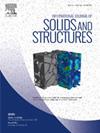A chemo-thermo-mechanical coupled phase-field model for complex early-age concrete mesoscale fracture simulations
IF 3.4
3区 工程技术
Q1 MECHANICS
International Journal of Solids and Structures
Pub Date : 2025-03-13
DOI:10.1016/j.ijsolstr.2025.113340
引用次数: 0
Abstract
Complex crack propagation at micro/meso-scale in heterogeneous early-age concrete is usually induced by non-uniform shrinkage and thermal expansion during hydration processes, directly affecting the loading-carrying capacity of concrete structures and their systems. Prediction of such early-age fracture is essential for investigating its effects on the macroscopic mechanical performance of concrete and further optimizing structural design. To this end, this study proposes a novel mesoscale hydration-induced fracture modelling method combining a chemo-thermo-mechanical coupled phase-field model and random aggregate models for complex mesoscale early-age concrete fracture simulations. In this method, the Fourier’s law and the Arrhenius’s law are used to simulate heat transfer and hydration reaction in heterogeneous models, respectively. The temperature and hydration degree of solids are fully incorporated into the governing equations of the phase-field regularized cohesive zone model to efficiently simulate complicated chemo-thermally induced fracture, without the need of remeshing, crack tracking or auxiliary fields. The resultant displacement-temperature-hydration degree-damage four-field coupled system of equations is solved using a staggered Newton–Raphson iterative algorithm within the finite element framework. The new method is first verified by a heat convection problem with numerical solutions and a hydration fracture problem of a concrete ring with experimental data. Mesoscale fracture modelling of an early-age concrete square is then carried out to investigate the effects of mesh size, phase-field length scale, boundary conditions, and the distribution and volume fraction of random aggregates, on concrete hydration. It is found that the present method is capable of accurately and robustly modelling chemo-thermally induced mesoscale multi-crack propagation, with insensitivity to mesh size and phase-field length scale. The capacity of modelling complex heterogeneous early-age cracking, as well as its potential for advancing structural design and optimization, is well demonstrated.
复杂早期混凝土中尺度断裂模拟的化学-热-力学耦合相场模型
非均质早期混凝土微细观尺度复杂裂纹扩展通常是水化过程中不均匀收缩和热膨胀引起的,直接影响混凝土结构及其体系的承载能力。早期断裂的预测对于研究其对混凝土宏观力学性能的影响以及进一步优化结构设计至关重要。为此,本研究提出了一种结合化学-热-力学耦合相场模型和随机集料模型的新型中尺度水化诱导断裂模拟方法,用于复杂的中尺度早期混凝土断裂模拟。该方法采用傅立叶定律和阿伦尼乌斯定律分别模拟非均相模型中的传热和水化反应。将固体的温度和水化程度完全纳入相场正则内聚带模型的控制方程中,可以有效地模拟复杂的化学-热致裂缝,而无需重新网格化、裂缝跟踪或辅助场。在有限元框架内,采用交错牛顿-拉夫森迭代算法求解了位移-温度-水化程度-损伤四场耦合方程组。本文首先通过一个具有数值解的热对流问题和一个具有实验数据的混凝土环水化断裂问题对新方法进行了验证。然后进行了早期混凝土广场的中尺度断裂建模,以研究网格尺寸,相场长度尺度,边界条件以及随机骨料的分布和体积分数对混凝土水化的影响。结果表明,该方法能够准确、稳健地模拟化学热诱导的中尺度多裂纹扩展,且对网格尺寸和相场长度尺度不敏感。模拟复杂非均质早期裂缝的能力及其在推进结构设计和优化方面的潜力得到了很好的证明。
本文章由计算机程序翻译,如有差异,请以英文原文为准。
求助全文
约1分钟内获得全文
求助全文
来源期刊
CiteScore
6.70
自引率
8.30%
发文量
405
审稿时长
70 days
期刊介绍:
The International Journal of Solids and Structures has as its objective the publication and dissemination of original research in Mechanics of Solids and Structures as a field of Applied Science and Engineering. It fosters thus the exchange of ideas among workers in different parts of the world and also among workers who emphasize different aspects of the foundations and applications of the field.
Standing as it does at the cross-roads of Materials Science, Life Sciences, Mathematics, Physics and Engineering Design, the Mechanics of Solids and Structures is experiencing considerable growth as a result of recent technological advances. The Journal, by providing an international medium of communication, is encouraging this growth and is encompassing all aspects of the field from the more classical problems of structural analysis to mechanics of solids continually interacting with other media and including fracture, flow, wave propagation, heat transfer, thermal effects in solids, optimum design methods, model analysis, structural topology and numerical techniques. Interest extends to both inorganic and organic solids and structures.

 求助内容:
求助内容: 应助结果提醒方式:
应助结果提醒方式:


